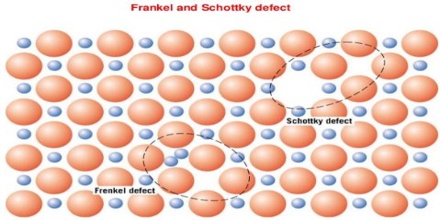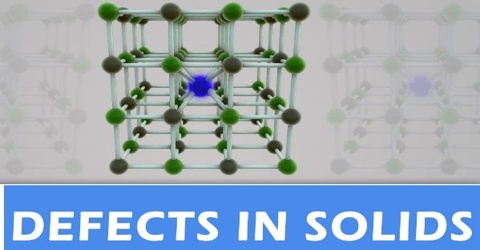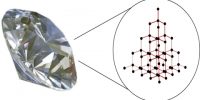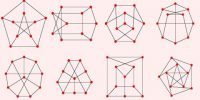Crystal detects
The presence of defects to crystal lattice may profoundly influence the mechanical, electrical and optical properties of crystal. Reactively of the solids may also be explained by considering the defect structure. Crystal detects are broadly divided into three classes:
(a) Point defect,
(b) Line defect and
(c) Plane defect.
Each one of these defects are subdivided into the following class;
Their formation:
(a) Point defects:
- Vacancy,
- Substitution,
- Interstitial,
- Frenkel,
- Schottky,
- Non-stoichiometric and
- Color centers.
(b) Line defects: Edge defect and Screw dislocation
(c) Plane defect: Grain boundary faults and Stackly faults.
A brief description of point detects are considered in this topic.
(i) Vacancy defects: Vacancy defects arise when some of the lattice points usually occupied by metal atom are vacant. (Figure). This can happen only at an elevated temperature.

Fig: a metal atom is missing from its lattice position
(ii) Substitutional defects: An atom or an ion may be substituted for another atom or ion. The substitution of an atom or an ion is dependent on the ionic radius and electronic structure. Two cases may be considered:
- A monovalent cation may be substituted by a divalent cation. For example, a Ag+ ion from AgCl may be substituted by a Ca2+ A Ag+ ion must also be removed for charge balance.
- Alternatively, a divalent canon may be substituted by a monovalent cation Substitution of Ni2+ by Li+ in NiO lattice will give rise to this kind of defect. The defect thus produced is known as valency detect
(iii) Interstitial defect: An atom or an ion may be introduced into an interstitial position. Thus a foreign atom B is incorporated at interstitial positions of an ionic crystal MX. The introduction of the impurity is critically determined by the relative sizes of the host (parent lattice) and the guest (impurity).
(iv) Frenkel defect: The Frenkel defect is also a kind of point defect. In this case an atom or an ion is removed from its normal lattice site and is placed at an interstitial position. As a result the crystal structure has a vacancy as well as an interstitial. An example is shown in Figure.

(v) Schottky defect: This is another kind of vacancy defecit. If the number of anion vacancies in a crystal is equal to the number of cation vacancies, the combination is called Schottky defect. The formation of Schottky defect is shown in Figure.
(vi) Non-stoichiometric: The Law of Definite Proportion, put forward by Berthollet at the beginning of the nineteenth century, states that the composition of a chemical compound must be constant. In other words elements must always combine in a definite ratio by mass. For example chemical formulas such as FeO or ZnO suggest that the constituent atoms/ions are present in stoichiometric ratio in these compounds. However, with the applications of sophisticated technique it became clear that there are deviations from stoichiometry in seemingly stoichiometric compounds. This deviation from stoichiometry in predominantly binary ionic solids implies that one of the constituent elements is in excess compared to the other.
(vii) Color centers: This is a kind of defect in which a colorless compound becomes colored. For example if NaCl (a colorless compound) is heated in an atmosphere of Na or K vapours and then quenched rapidly it becomes colored.
However, the presence of these lattice defects gives rise to special electrical and optimal properties. The strength and hardness of metals also depend markedly on defects in their crystal structure.














